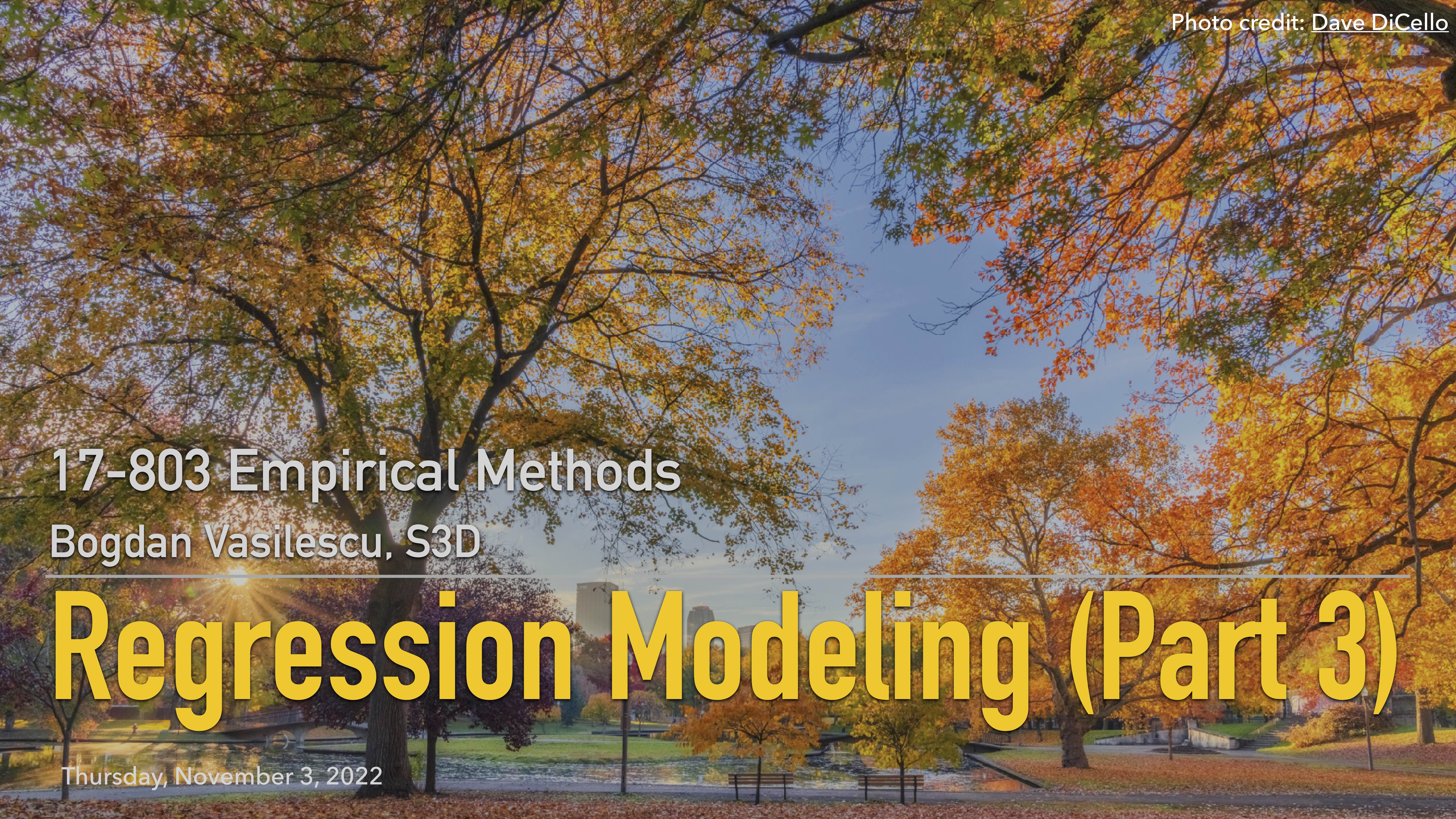empirical-methods
Homepage for 17-803 "Empirical Methods" at Carnegie Mellon University
Project maintained by bvasiles Hosted on GitHub Pages — Theme by mattgraham
L16: Linear Regression (Part III) (pdf, video)

In this third lecture in the regression series we talked about Simpson’s paradox, how to account for within- and between- subject effects in the same model, and briefly about mixed-effects models. We also discussed two exemplar papers. Finally, we applied what we learned about regression so far to the Galton height dataset as part of an in-class hands-on activity (see the R markdown part of the slides for details).
Exemplars
Woolley, A. W., Chabris, C. F., Pentland, A., Hashmi, N., & Malone, T. W. (2010). Evidence for a collective intelligence factor in the performance of human groups. Science, 330(6004), 686-688.
Peoples, B. K., Midway, S. R., Sackett, D., Lynch, A., & Cooney, P. B. (2016). Twitter predicts citation rates of ecological research. PloS One, 11(11), e0166570.
Lecture Readings
Bates, D., Mächler, M., Bolker, B., & Walker, S. (2015). Fitting Linear Mixed-Effects Models Using lme4. Journal of Statistical Software, 67(1), 1 - 48.
Official vignette for the lme4 package in R, that describes the syntax and how to specify and interpret mixed-effects linear regression models.
Bell, A., & Jones, K. (2015). Explaining fixed effects: Random effects modeling of time-series cross-sectional and panel data. Political Science Research and Methods, 3(1), 133-153.
Bell, A., Fairbrother, M., & Jones, K. (2019). Fixed and random effects models: making an informed choice. Quality & Quantity, 53(2), 1051-1074.
Both papers assess the options available to researchers analyzing multilevel (including longitudinal) data, with the aim of supporting good methodological decision-making. Capabilities and limitations of fixed and random effects (FE and RE) models are presented, together with the within-between RE model – the most general of the three, with all the strengths of the other two.
The earlier paper argues that “there are few, if any, occasions in which FE modeling is preferable to RE modeling” and that “a well-specified RE model can be used to achieve everything that FE models achieve, and much more besides.” Fun read.
McNeish, D., & Kelley, K. (2019). Fixed effects models versus mixed effects models for clustered data: Reviewing the approaches, disentangling the differences, and making recommendations. Psychological Methods, 24(1), 20.
This article discusses the differences between mixed effects and fixed effects models for clustered data, reviews each approach, and helps to identify when each approach is optimal. It then discusses the within–between specification, which blends advantageous properties of each framework into a single model.
There is overlap in content with the Bell et al papers above.
Hair Jr, J. F., & Fávero, L. P. (2019). Multilevel modeling for longitudinal data: concepts and applications. RAUSP Management Journal.
Another paper that discusses multilevel modeling for longitudinal data, clarifying the circumstances in which they can be used.
Hox, J. J., Moerbeek, M., & Van de Schoot, R. (2017). Chapter 2 from Multilevel analysis: Techniques and applications. Routledge.
The multilevel regression model is commonly needed and used. Such models assume that there is a hierarchical data set, with one single outcome or response variable that is measured at the lowest level, and explanatory variables at all existing levels. Conceptually, it is useful to view the multilevel regression model as a hierarchical system of regression equations. This chapter explains the multilevel regression model for two-level data.
Additional Readings
Bell, A., Jones, K., & Fairbrother, M. (2018). Understanding and misunderstanding group mean centering: a commentary on Kelley et al.’s dangerous practice. Quality & Quantity, 52(5), 2031-2036.
“Group-mean-centering is, in short, no more dangerous than any other statistical procedure, and should remain a normal part of multilevel data analyses where it can be judiciously employed to good effect.”
Townsend, Z., Buckley, J., Harada, M., & Scott, M. A. (2013). The choice between fixed and random effects. The SAGE handbook of multilevel modeling, 73-88.
Clark, T. S., & Linzer, D. A. (2015). Should I use fixed or random effects. Political Science Research and Methods, 3(2), 399-408.